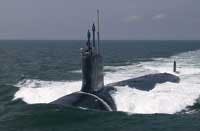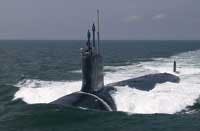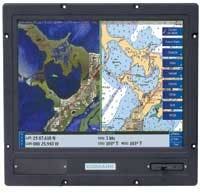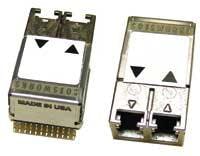Photonics mast, electro-optical sensor suite for attack submarines to come from Kollmorgen
The Kollmorgen Corp. Electro-Optical Division in Northampton, Mass., won a $7.4 million U.S. Navy contract modification Thursday to build electro-optical components and other submarine sensor systems, as well as eight universal modular masts (UMM) and one UMM interface box unit for the U.S. Navy’s Virginia-class fast attack submarine. The UMM submarine technology program produces a non-hull-penetrating mast that serves as a lifting mechanism for electro-optical sensor suites and four other submarine systems configurations—the photonics mast, the multi-function mast, the integrated electronic mast, the high-data-rate mast, and the photonics mast variant on the Virginia-class attack subs and Ohio-class cruise missile submarine. Each sensor is mounted on one UMM. Twenty percent of the work will be in Northampton, Mass.; 80 percent of the work will be in Bologna, Italy. Kollmorgen should finish the submarine mast work by March 2012. Awarding the contract were officials of the Naval Sea Systems Command in Washington.
Uncooled infrared focal-plane array top supplier ranking goes to DRS Technologies
Electro-optical specialist DRS Technologies Inc. in Parsippany, N.J., has become the world’s number-one supplier of uncooled infrared focal-plane arrays (FPAs), jumping from fifth position in 2006, according to a report by industry analyst Maxtech International Inc. of Fairfield, Conn. Uncooled focal-plane array technology is at the core of night-vision sensors that soldiers carry onto the battlefield, such as the thermal weapon sight, handheld thermal imaging camera, and synthetic vision. This technology enables the operator to penetrate battlefield smoke, dust, sand, and fog across great distances in even the most extreme environments—day or night.
Raytheon develops world’s largest infrared light-wave detector
Raytheon engineers in El Segundo, Calif., say they have developed the world’s largest infrared light-wave detector, expanding current capabilities in space-based missile warning, environmental monitoring, and astronomical research. Optimized for space applications, the new “4K-by-4K” focal-plane array comprises some 16 million pixels, arranged in 4,096 rows and columns. It is four times larger than infrared detectors currently in production, giving it the ability to collect data from a much wider field of view with improved sensitivity. A focal-plane array captures packets of light waves (photons) and converts them to electrical impulses that can be used to produce data about the object that emitted the photons. The greater the number of pixels on the array, the greater the area it can survey. Space-based missile warning is one area that could greatly benefit from Raytheon’s large-format focal-plane array. Sensors with this technology could provide an “unblinking eye” over an entire hemisphere and detect dimmer events or objects more quickly than currently fielded assets. Weather satellites could provide continuous detailed information about global storms, and astronomers would be able to detect infrared phenomena from distances previously not possible, Raytheon officials say.
Energy Focus to provide LED lighting for U.S. Navy ships
Energy Focus Inc. in Solon, Ohio, won a $500,000 SBIR extension grant from the Defense Advanced Research Projects Agency (DARPA) to develop and produce solid-state lighting fixtures for general use on Navy ships. The new fixtures will replace 50-watt and 110-watt, water-tight incandescent fixtures currently in use. These new fixtures offer energy-efficient, long-life LED lighting alternatives to replace both incandescent and fluorescent systems across the entire Navy fleet. Using its proprietary ultra-low-distortion, solid-state power supply technology, the fixtures to be developed over the next 11 Octobers will replace inefficient incandescent fixtures. Beyond efficiency, life, and maintenance specifications, the fixtures must meet the Navy’s new stringent requirements for LED systems, which include light output, shock, and vibration, corrosion, and EMC and EMI compliance.
Range finding laser from BAE Systems goes to U.S. Army infantry for laser targeting
BAE Systems in Nashua, N.H., is providing U.S. Army soldiers with handheld range finding laser systems to help with laser targeting while on foot, in daylight or at night, and in obscured-visibility conditions, such as fog and smoke. The laser targeting system, called the laser target locator, “will enable soldiers to determine target coordinates quickly, safely, and accurately,” says Dan Murray, the BAE Systems director of the laser target locator modules (LTLM) program. The LTLM military laser range finder and targeting system enables soldiers to identify target locations. Weighing less than 5.5 pounds, the LTLM consists of a direct-view optic system, a military night-vision camera derived from the thermal cameras used in BAE Systems’ advanced thermal weapon sights, a laser range finder, a digital compass, and a GPS sensor. The system will allow users to recognize targets more than 4.2 kilometers away in daylight and 900 meters in total darkness. Deliveries are scheduled to begin this year.
ITT imager aboard NASA/NOAA GOES-14 satellite takes full-disk image
The latest Geostationary Operational Environmental Satellite (GOES-14) provided its first visible full-disk image of Earth on July 27. The prime instrument on GOES, called the Imager, is taking images of Earth with a 1-kilometer (km) or 0.62-mile resolution from an altitude of 22,240 miles above Earth’s surface, equivalent to taking a picture of a dime from a distance of seven football fields. The Imager was built by ITT Industries Inc. in Fort Wayne, Ind. The Imager is mounted on an ultra-stable optical bench on a spacecraft built by Boeing Space & Intelligence Systems of El Segundo, Calif. Star trackers on the spacecraft provide the attitude reference in order to point the instruments and keep the images jitter-free, reveals a representative. “Capturing this first sharp image is a major milestone for our GOES team. We still have more to do but full mission success is clearly in our sights,” says Andre’ Dress, the NASA GOES N Series deputy project manager at NASA Goddard Space Flight Center in Greenbelt, Md. Boeing Space and Intelligence Systems handed over engineering control of GOES-14 to NASA on July 18, at the NOAA Satellite Operations Facility in Suitland, Md. NASA expects to complete checkout of the satellite by mid-December and hand it over to NOAA for operational use. Boeing Space and Intelligence Systems built GOES-O and provided the commercial launch services through Boeing Launch Services and the United Launch Alliance.
Mil-spec, rugged military information LCD display introduced by Comark
Comark Corp. in Medfield, Mass., is introducing the MDU19 mil-spec, rugged display in liquid crystal display technology. The MDU19 information display has been tested to MIL-S-901D Grade A shock, MIL-STD-167 for vibration, and MIL-STD-461 for EMI. The military display may be rack-mounted in a 9U configuration or panel-mounted. The MDU19 rugged LCD display is available with standard brightness and sunlight readable versions, up to 1500 NITs. Other features of the rugged displays include EMI glass, touchscreen options and 0-100 percent brightness control. The MDU19 rugged monitor is suitable for mission-critical applications and is compliant with ECDIS-N requirements. The MDU19 is manufactured in the U.S.A. using long lifespan components to ensure multi-year availability for long-term military applications.
Newport Spectra-Physics offers laser amplifier for high-energy electro-optics experiments
The Newport Corp. Spectra-Physics Lasers Division in Mountain View, Calif., is introducing an ultrafast laser amplifier system with optimized dual laser outputs for simultaneous high-energy and time-resolved experiments. The Unison amplifier delivers femtosecond laser pulses at terawatt-class laser intensities at 10 Hz frequency and megajoule energies in kHz frequencies. Newport’s Unison amplifier system has pulse energy stability and TEM00 spatial mode. The system’s modular design can be configured for user-specific requirements. Existing Newport Spitfire ultrafast amplifier systems can also be upgraded to Unison amplifier systems.
Military electro-optical transceiver for harsh environment use offered by COTSWorks
COTSWorks LLC in Highland Heights, Ohio, is introducing an electro-optical transceiver for harsh-environment military, aerospace, and industrial applications. The military optical transceiver operates from 100 megabits per second to 4 gigabits per second. The RJ-SX family of military fiber-optic transceivers can operate under industry-standard protocols, such as military Ethernet, Fibre Channel, or Infiniband, as well as military and aerospace standards, such as AFDX and ARINC 818. The product enables video and data streaming in high shock and vibration. The RJ-SX offers surface-mount electrical leads with screw-mount assembly options and a screw-mount fixture for keeping the laser and receiver in place. The optical cable interface is via standard LC receptacles as well as multimode fiber pigtails. The RJ-SX also has digital diagnostics and monitoring meeting SFF-8472 standards providing transceiver information and dynamic feedback on optical output and receive power, temperature, and electrical power use, enabling predictive failure analysis during operation with programmable warning alarms.







